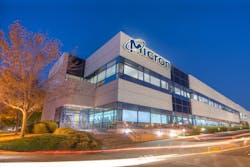Micron's $15 Billion to Fund First New U.S. Memory Fab in Decades
Micron said it will spend $15 billion over the next decade to build a new advanced memory fab in Boise, Idaho. The company touted it as the first new memory plant constructed by a U.S. company in the last 20 years.
This week, Micron broke ground on the new factory, which will be located in the vicinity of the company’s headquarters and its most advanced research and development lab. The site will apparently have the largest cleanroom ever built in the U.S when complete. Micron marked the occasion with a ceremony attended by U.S. Secretary of Energy Jennifer M. Granholm, Idaho Senator Jim Risch, and Idaho Governor Brad Little.
Touted as the largest U.S.-based manufacturer of DRAM and NAND flash chips, Micron intends to start building the Boise fab in early 2023. Full production in the vast cleanroom space will start in phases in 2025.
CEO Sanjay Mehrotra said in a statement that the new fab will drive U.S. technology leadership while enhancing “Micron’s supply chain resilience, and will establish a new strategic capability for the U.S.”
Micron said the Boise fab will be the first of several U.S. investments made possible thanks to anticipated grants and tax credits offered by the CHIPS and Science Act. President Joe Biden signed the bill last month.
Last month, it announced plans to spend $40 billion by 2030 to expand its memory manufacturing capacity in the U.S. The huge investment will create up to 40,000 new American jobs, including about 5,000 roles at Micron.
CHIPS Act
The new law, also called the CHIPS+ Act, will allocate more than $50 billion in subsidies and grants to companies that invest in new U.S. fabs. The legislation is the linchpin in the U.S. government’s strategy to rebuild the nation’s manufacturing might in chips, which are increasingly critical to both national security and the economy.
The prospect of federal subsidies has lured tens of billions of dollars of investment in the U.S. by the world’s largest chip makers, including GlobalFoundries, Intel, Samsung, Texas Instruments, and TSMC, among others.
Micron’s announcement stands in stark contrast to the weakening prospects for the memory market. Memory-chip sales have collapsed in recent months as companies start to work through a vast backlog of inventory.
The near-term demand for memory and storage is facing challenges. But Micron said sales of memory chips in markets like data centers, industrial, automotive, and mobile could double by 2030, driven by AI and 5G. As a result, the company requires new wafer production capacity to stay ahead of long-term demand.
And, even though it’s not the best time to build a semiconductor fab, Micron is not investing as aggressively as other firms. The new investment translates to only about $1.5 billion of spending per year over a decade.
The cleanroom space in the new plant will eventually occupy 600,000 square feet, roughly equal to 10 U.S. football fields. That represents what Micron claims will be the largest single cleanroom ever built in the country.
Micron said the Boise fab will employ the most advanced semiconductor manufacturing processes and equipment, including extreme-ultraviolet (EUV) tools that will help it push the performance envelope over several generations of DRAM.
There are also advantages to building the fab close to its main research and development lab. This includes closer collaboration between engineering and manufacturing teams and faster time to market for new chips.
Factory Roadmap
Micron aims to start mass production of DRAM at the new facility in 2025. It plans to increase its manufacturing capacity in the ensuing years to stay ahead of industry demand.
The new fab will need to be staffed, and many of the new roles require qualified candidates with high-end degrees. In addition to creating 17,000 jobs in the state, Micron expects to hire for 2,000 full-time positions at the fab.
To enrich its talent pipeline for years to come, Micron said it also plans to invest in expanding science and engineering education to K-12 and university students through partnerships with institutions in the region. Additionally, the company has partnered with regional colleges to create new technology-focused degrees that will pave the path for students who intend to join Micron’s technical apprenticeship program.
Increasing memory production promises to give it a more geographically diverse supply chain, which has become a high priority for its customers amid the global chip shortage that has lasted two years.
Jeff Clarke, co-chief operating officer at Dell Technologies, one of Micron’s largest clients in the U.S., said the new Boise facility “will be a positive development toward creating more chip capacity in the U.S.”
While the new facility will be the first memory fab to be built in the U.S. in decades, it will likely not be the last. The company said it’s in the final stages of the selection process for another high-volume manufacturing site on home soil.
Once operational, U.S. fabs will account for 40% of Micron’s DRAM output globally, up from 10% today.
Currently, only one out of every 50 memory chips is made in the U.S. But the company has pledged to build enough capacity so that around one of every 10 memory chips will be U.S.-made by 2030.
About the Author
James Morra
Senior Editor
James Morra is the senior editor for Electronic Design, covering the semiconductor industry and new technology trends, with a focus on power electronics and power management. He also reports on the business behind electrical engineering, including the electronics supply chain. He joined Electronic Design in 2015 and is based in Chicago, Illinois.

